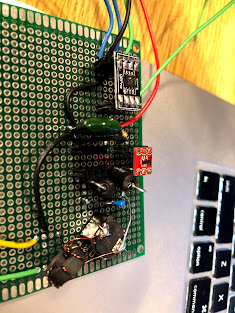I recently saw this post where the person made a cheap and cheerful FT8 setup using an Si5351/amplifier and an RTL-SDR. I thought "hey, I have all those parts", so I thought I'd give it a go.
So far, I've done two parts. After I got my dipole back up and tested it with the NanoVNA, I plugged my RTL-SDR in and got it working with WSJT-X. I used a 40M bandpass filter I had built (because I had it), and got results right away.
For my later reference, my setup was
- CubicSDR on “direct sampling - Q"
- Tune to 7.074MHz *upper side band*, bandwidth ~3k
- Turn on Loopback, with the source being CubicSDR
- Turn on WSJT-X, pick “Loopback audio” as the input
- Set WSJT-X to be on 40M/7.074
Today I dug out the "Mighty Mike" amp I built some years back and verified it still worked. Connected an Arduino to an Si5351 board, that into the amp, and that through a low-pass filter.
I used the software here and didn't use their other one that actually interfaced with WSJT-X yet, as that seems to need a patched version and didn't feel up for getting that to work yet. As is, took me a bit to get it working, as there were a bunch of libraries I needed to install (wasn't clear which ones when I started), and I had trouble with the "weakmon" library it used (it was trying to load an ".so" file that it couldn't find. Had to build that and then update the code to reference the exact path). But after that saw their nice little terminal screen.
So just transmitted from there (not doing any receiving) and looked for myself on PSKReporter. Bam. Success! I probably wasn't even putting out a watt, and my dipole is *really* low, so pretty stoked.
I need to build the relay TR they describe, and need to figure out how to get that patched version of WSJT-X working (as I really don't want to try to build that on my mac...), but that is a project for another day.














